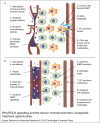Rho-associated kinase signalling and the cancer microenvironment: novel biological implications and therapeutic opportunities
- PMID: 26507949
- PMCID: PMC4836205
- DOI: 10.1017/erm.2015.17
Rho-associated kinase signalling and the cancer microenvironment: novel biological implications and therapeutic opportunities
Abstract
The Rho/ROCK pathway is involved in numerous pivotal cellular processes that have made it an area of intense study in cancer medicine, however, Rho-associated coiled-coil containing protein kinase (ROCK) inhibitors are yet to make an appearance in the clinical cancer setting. Their performance as an anti-cancer therapy has been varied in pre-clinical studies, however, they have been shown to be effective vasodilators in the treatment of hypertension and post-ischaemic stroke vasospasm. This review addresses the various roles the Rho/ROCK pathway plays in angiogenesis, tumour vascular tone and reciprocal feedback from the tumour microenvironment and explores the potential utility of ROCK inhibitors as effective vascular normalising agents. ROCK inhibitors may potentially enhance the delivery and efficacy of chemotherapy agents and improve the effectiveness of radiotherapy. As such, repurposing of these agents as adjuncts to standard treatments may significantly improve outcomes for patients with cancer. A deeper understanding of the controlled and dynamic regulation of the key components of the Rho pathway may lead to effective use of the Rho/ROCK inhibitors in the clinical management of cancer.
Figures


References
-
- Ferlay J. et al. (2015) Cancer incidence and mortality worldwide: sources, methods and major patterns in GLOBOCAN 2012. International Journal of Cancer 136, E359–E386 - PubMed
-
- Shimokawa H. and Rashid M. (2007) Development of Rho-kinase inhibitors for cardiovascular medicine. Trends in Pharmacological Sciences 28, 296–302 - PubMed
-
- Itoh K. et al. (1999) An essential part for Rho-associated kinase in the transcellular invasion of tumor cells. Nature Medicine 5, 221–225 - PubMed
Publication types
MeSH terms
Substances
Grants and funding
LinkOut - more resources
Full Text Sources
Other Literature Sources
Research Materials

